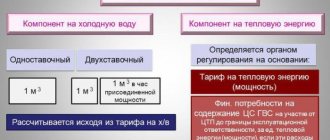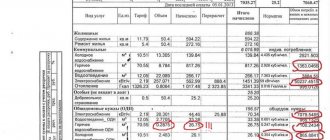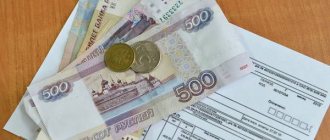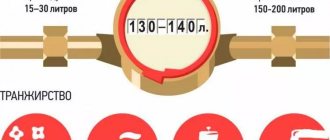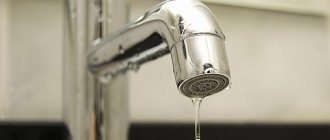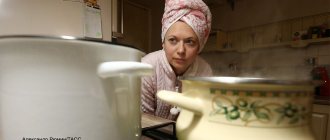- March 5, 2020
- Plumbing
- Plugatareva Yana
People who have just started living separately are often lost in some everyday situations, for example, they don’t know how to approach water meters. Because of this, problems arise with paying utilities or repaying debts. In this article we will tell you how to count hot water using meters.
Where to begin
To measure the readings correctly, you need to know which riser is responsible for cold water and which is responsible for hot water. This will allow you not to confuse the readings and pay for utilities correctly. As a rule, the hot water riser is located higher.
How to count hot water by meters? There is an indicator on the external panel of the meter that displays water consumption. There is also a circular scale of water flow, the meter model and a water movement indicator are indicated.
We need an eight-digit water flow indicator. The last three digits are red and the first five are black.
Calculation of domestic hot water using an individual meter
An independent calculation may be necessary to reconcile with the amount indicated in the receipt for consumed hot water. The calculation procedure is stipulated by regulatory documents and is carried out according to a specialized formula.
To calculate the cost of hot water supply if there is a metering device in a residential or non-residential premises, it is necessary to multiply the volume of water consumed for a certain time of use by the cost of cold water, that is, by the first component of the two-component tariff.
How is water payment calculated?
The volume of liquid is measured by a meter in cubic meters. After this, the second part of the tariff, established in accordance with the legislation of the Russian Federation, should be multiplied by the amount of thermal energy spent on heating water.
The indicator is calculated by multiplying the volume of hot water consumed over a certain period by the standard consumption of thermal energy spent on heating water. The products obtained during the calculations must be summed. The resulting number will be the amount of payment for hot water supply in the room with a meter.
Taking readings
How to count hot water by meters if you have never done this? Red color indicates water consumption in liters; this indicator is not needed when measuring. But black numbers indicate water consumption in cubic liters, and they are used to pay for the service.
For example, a new meter was recently installed, and in a month it showed 00013950. The numbers mean that in a month you spent thirteen cubic meters of hot water and 950 liters. To make it more convenient, it is better to round the result to as many as fourteen cubic meters and pay according to this data.
What is the cost of hot water supply?
In the Russian Federation, cold and hot water supplies are recorded separately. The cost of hot water supply includes the cost of energy spent on heating water, the volume of liquid, the price of chemicals intended for water purification, etc. The calculations take into account the cost of thermal energy spent on heating cold water. Depending on the region, the price of thermal energy may differ. The indicator is calculated taking into account several factors:
- Costs for maintenance and repair of equipment used to heat water. To supply hot water, specialized boiler houses are required. Equipment requires maintenance and repair costs.
- Possible heat loss when transporting hot water through pipelines.
- Price for services for delivering liquids to the premises.
- Tariff for heating hot water in a certain region of the Russian Federation.
Paying for hot water supply using a single tariff is impractical. The price for hot water supply was divided into two components - the cost of water and the amount of heat to heat it. If necessary, you can independently calculate the service fee.
Counting water using a meter
How to count hot water by meters? The correct calculation of water will be if you follow the rule when calculating. If in the first month seventeen liters of water were consumed, and in the next month there are already thirty liters on the meter, this does not mean that in the second month you spent 30 liters. It is necessary to subtract the readings for the first from the hot water meter readings for the second month. That will be thirteen liters, which the owner of the apartment will pay for.
The meter readings must be monitored regularly so that they do not diverge from the values. If the readings do not agree, then it is time to look for a leak. Faucets or radiators may leak.
Whom to pay?
Payment for cold water and hot water goes to different accounts, since the delivery is usually carried out by different organizations.
Since the tariff for hot water in many regions has become equal to the tariff for thermal energy,
hot water supply is supplied by an authorized heating organization , and cold water supply is supplied by the water utility.
Private clients enter into an agreement with a heating organization serving a given region.
At the same time, many local organizations provide services to the population by default, without concluding written agreements, or by concluding a single contract with the management company.
The basis is PP No. 354, which states that if the client committed implied actions, i.e. actually already consumes the services or intends to do so, there is no need to enter into a written contract.
We pay for water
After the hot water meter readings are taken, you need to pay for the service. This can be done at payment points in your locality, the amount is calculated simply - the tariff for hot water is multiplied by the number of liters consumed.
It is most convenient to pay for services at the end of the month. If payment has not been made for the month, then you will have to pay according to the average readings for the month. This means that the fifteen cubic meters of water spent last month will be counted next month.
A hot water meter with a temperature sensor allows you to pay for the water actually used, while paying according to average indicators almost always means overpaying.
Hot water supply can be non-centralized or centralized. In the first case, hot water appears in autonomous in-house utility systems. A heater or boiler can be installed in a private house.
Tariffs are set only for hot centralized water supply, so there are several types of the latter.
CALCULATION OF THE HOURLY MAXIMUM HOT WATER CONSUMPTION OF A PRIVATE HOUSE
Water consumption for hot water supply needs should be determined according to hot water consumption standards, taking into account the likelihood of using water taps.
The load on the hot water system is determined by the maximum flow of hot water and taken into account when choosing a heat source. Hello, dear friends! We are accustomed to using hot water every day and can hardly imagine a comfortable life if we cannot take a warm bath or have to wash dishes under a tap from which a cold stream flows. Water at the desired temperature and in the right quantity is what the owner of every private home dreams of. Today we will determine the estimated water and heat consumption for hot water supply to our home. You must understand that at this stage it is not particularly important to us where we get this heat. Perhaps we will take it into account when choosing the power of the heat supply source and will heat water for the needs of hot water supply in the boiler. Perhaps we will heat the water in a separate electric boiler or gas water heater, or perhaps it will be delivered to us. Well, if there are no technical capabilities to implement a hot water system at home, then we will go to our own or the village bathhouse. Our parents mostly went to the city baths, and now the mobile Russian bathhouse under your window has rung. Of course, life does not stand still and having a bath and shower in the house today is no longer a luxury, but a simple necessity. Therefore, we will provide a hot water supply system in the house. The correct calculation of the hot water supply will determine the load on the domestic hot water system and, ultimately, the choice of the power of the heat source. Therefore, this calculation must be approached very seriously. Before choosing the design and equipment of a domestic hot water system, we need to calculate the main parameter of any system - the maximum consumption of hot water per hour of maximum water consumption (Qg.vmax, kg/h).
In practice, using a stopwatch and a measuring container, we determine the consumption of hot water, l/min when filling the bathtub
Types of water supply
It is not enough to install a hot water meter with a temperature sensor; you also need to understand what type of water supply is in your home.
In a centralized open scheme, hot water is taken directly from the heating network. In such conditions, a two-component tariff is established, consisting of a component for thermal energy and a component for coolant. The thermal energy component is set by the regulatory body. It is he who chooses a two-rate or one-rate component, which is equal to the tariff of the same name.
For utilities, water is used as a coolant component, which has undergone additional processing in the boiler room. The single-rate component is calculated at the same rate.
After installing a hot water meter, otherwise called an in-house metering device, the amount of water consumed is calculated as follows:
- The apartment building is located in the Omsk region. Residents consume 5 cubic meters of hot water per month.
- This means that the coolant component will cost 17.82 rubles per cubic meter, and the thermal energy component will cost 1,422 rubles per Gcal.
How is the charge for hot water supply calculated? What is DHW heating
Charging for hot water supply consists of two parts, or components, each of which is highlighted in a separate line on the receipt - DHW and DHW heating. This is due to the fact that water preparation in houses is carried out directly by the management company in individual heating points of each house. In the process of preparing hot water, two types of utility resources are used - cold water and thermal energy.
The first component, the so-called hot water supply, is directly the volume of water that passed through the hot water supply meter and was consumed in the room in a month. Or, if the readings were not taken, or the meter turned out to be faulty or its verification period has passed, the volume of water determined by calculation according to the average or standard for the quantity prescribed. The procedure for calculating the volume of DHW supply is exactly the same as for cold water supply. To calculate the cost of this service, the tariff for cold water is applied, since in this case it is cold water that is purchased from the supplier.
The second component, DHW heating, is the amount of thermal energy that was expended to heat the volume of cold water provided to the apartment to hot temperature. This amount is determined based on the readings of the common house heat energy meter.
In general, the fee for hot water supply is calculated using the following formula:
Pigv = Vigv × Txv + (Vvcr × Vigv / ∑ Vigv × Tvcr)
Where:
Vigv - the volume of hot water consumed during the billing period (month) in an apartment or non-residential premises
Tхв - tariff for cold water
Vvкр - the volume of thermal energy used during the billing period for heating cold water during the independent production of hot water by the management company
Vigv - the total volume of hot water consumed during the billing period in all rooms of the house
Tvкр - tariff for thermal energy
Calculation example: Let’s assume that hot water consumption in an apartment for a month is 7 m3. Hot water consumption throughout the house is 465 m3. The amount of thermal energy spent on heating hot water according to a common house meter is 33.5 Gcal 7 m3 * 33.3 rubles. + (33.5 Gcal * 7 m3 / 465 m3 * 1331.1 rub.) = 233.1 + 671.3 = 904.4 rub., Of which: 233.1 rub. – payment for actual water consumption (DHW heating line in the receipt) 671.3 – payment for thermal energy spent on heating water to the required temperature (DHW heating line in the receipt)
In this example, 0.072 gigacalories of thermal energy were spent to heat one cube of hot water.
The value showing how many gigacalories were required to heat 1 cubic meter of water in the billing period is called the DHW heating coefficient
The heating coefficient is not the same from month to month and largely depends on the following parameters:
1. Cold water supply temperature. At different times of the year, the cold water temperature ranges from +2 to +20 degrees. Accordingly, in order to heat water to the required temperature, different amounts of thermal energy will have to be expended. 2. The total volume of water consumed per month in all rooms of the house. This value is largely influenced by the number of apartments that submitted their testimony in the current month, recalculations, and, in general, the discipline of residents in submitting their testimony. 3. Thermal energy consumption for hot water circulation. Water circulation in the pipes occurs continuously, including during the hours of minimum water consumption. That is, for example, at night, hot water is practically not used by residents, but thermal energy for heating water is still spent to maintain the required temperature of hot water in heated towel rails and at the entrances to apartments. This figure is especially high in new, sparsely populated buildings and stabilizes as the number of residents increases.
Counter differences
Installing a hot water meter solves many problems, but only if it is installed correctly.
Individual metering devices allow you to control resource consumption, and therefore save. An apartment can have one or two metering devices installed, it all depends on the structure of the house.
Water meters are visually different and you need to study these differences before purchasing.
- Data on the packaging. The abbreviation DHW is indicated on the hot water meter box. Such a meter can be used for any system, but cold water meters should be installed only for their intended purpose.
- Factory seal or lines on the body. Cold water meters have blue markings, and hot water meters have red markings. By looking at the seal, you can quickly determine what kind of water the meter is intended for.
- Maximum water temperature. On the main part of each meter there are technical specifications, which indicate the extended temperature range. For hot water, the maximum temperature is ninety degrees, and for cold water meters, from thirty to fifty degrees, depending on the manufacturer.
Modern meters are practically no different from each other, so it is necessary to clarify the information in the device passport.
When purchasing, you need to look at the date the device was tested; the next month is counted from it.
Water consumption standards according to SNiP
The consumption of hot liquid consumed over a certain period of time is determined by specialized metering devices. If there is no meter, the ship is calculated based on the standard, according to SNiP.
An example of calculation for cold water and hot water in the Moscow region
The amount of liquid consumed depends on the type of water consumer:
- Residential premises with existing water supply and sewerage - 120 liters per day per person.
- Similar residential premises have gas supply - 150 liters per day.
- Premises with existing water supply, sewerage, bathroom and solid fuel water heater - 180 liters per day.
- Similar houses or apartments with water heaters, the energy carrier of which is gas - 225 l.
- The same rooms with high-speed gas heaters - 250 l.
- Apartments with centralized hot water supply – 230 l.
In practice, it is more economically profitable to use metering devices than to calculate consumption based on established standards. Actual water consumption rates are less than those stated in regulatory documents.
Important Rules
How to calculate hot water using a meter? There are many examples of calculations, but each of them is based on certain rules.
- Numbers to the decimal point are indicated first. There are zeros before the comma, which do not need to be written on the receipt.
- When the last three digits are greater than six hundred, the values are rounded to the nearest cube. This is not necessary, but it is not a violation either.
Data is taken from the meter according to the following scheme:
- The combination of numbers on the meter, for example, 00018.641, indicates the amount of water consumed over a certain time. In a specific example, residents used more than 18 cubic meters of water.
- If the decimal values are more than six hundred, then the user must round them up. That is, you need to pay for 19 cubic meters of water.
- By the end of the next period, the figure will increase, so it will be necessary to subtract the old ones from the new readings.
Usually the owner of the premises does not deal with the calculations; the management company does this for him. But in those settlements where there are no management companies, residents have to take readings themselves.
A good example
How to calculate hot water using a meter? Not only the owner, but also anyone else living in the apartment can pay for utilities. To calculate the payment amount, you need to know the following information:
- Hot water meter readings.
- Hot water meter information for the previous month.
- Tariff valid in a specific region. It is different for each region, so you need to check in advance how much a cube of hot water costs in your city. This information can be found on your payment receipt or on the website where the current rate is published.
The data is calculated according to the following algorithm:
- Data is taken from the metering device.
- Compare with the figures for the previous month. Smaller readings are subtracted from larger readings.
- Find out regional tariffs for hot water. How much a cube of hot water costs depends on the area. For example, in Moscow a cube costs 173 rubles.
- The calculation result must be multiplied by the tariff.
Some management companies have an online calculator on their website through which you can calculate payments for hot water. If the tariff in the receipt does not correspond to the current one, then you need to contact the management company. Evidence of illegal actions must be taken directly to court.
How to calculate the cost of hot water
According to Decree No. 1149 of the Government of the Russian Federation (dated November 8, 2012), the cost of hot water is calculated according to a two-component tariff for closed and open heat supply systems:
- in open ones - using components for coolant and thermal energy (according to Article 9, Clause 5 of Federal Law No. 190);
- in closed ones - using components for cold water and thermal energy (according to Article 32, paragraph 9 of Federal Law No. 416).
The format of the invoices has also changed, dividing the service into two lines: consumption of hot water (in tons) and thermal energy - Q. Previously, the tariff for hot water supply (hot water supply) was calculated for 1 m3, already including the cost of this volume of cold water and thermal energy consumed to heat it.
Dependency of calculation order
Depending on the price of the components, the estimated cost of 1 m3 of hot water supply is determined. For calculations, consumption standards in force in the territory of the municipality are used.
The procedure for calculating the cost of hot water by meter depends on:
- type of home heating system,
- the presence (absence) of a common house appliance, its technical characteristics that determine whether it can distribute Q for water supply and heating needs,
- presence (absence) of individual devices,
- suppliers of thermal energy and coolant.
The division into the price per cubic meter of cold water and heating costs, among other things, should encourage management companies servicing the housing stock to combat direct heat loss - to insulate the risers. For owners, two-component tariffing means that the payment for 1 m3 of hot water supply may vary relative to the standard if the actual consumption Q exceeds.
Apartment buildings without building flow meters
The quantity Q for heating 1 m3 of hot water is determined according to the recommendations of the State Tariff Committee, according to which the volume of thermal energy is calculated using the formula: Q = c * p * (t1– t2) * (1 + K).
This formula for consumed cubic meters takes into account the heat loss coefficient on centralized hot water pipelines.
- C – heat capacity of water (specific value): 1×10-6 Gcal/kg. x 1ºC;
- P – weight of water (volume); 983.18 kgf/m3 at t 60° C;
- t1 is the average annual temperature of hot water from centralized systems, taken as 60°C (the indicator does not depend on the heat supply system);
- t2 is the average annual cold water temperature from centralized systems, taken according to the actual data of those enterprises that supply cold water to organizations that prepare hot water (for example, 6.5°C).
Based on this, in the example below, the amount of thermal energy will be:
Q=1*10-6 Gcal/kg * 1ºC * 983.18 kgf/m3 * 53.5°C * (0.35 + 1) = 0.07 Gcal/m³
Its cost for 1 m3:
1150 rub./Gcal (DHW tariff) * 0.07 Gcal/m³ = 81.66 rub./m³
DHW tariff:
16.89 RUR/m³ (cold water component) + 81.66 RUR/m³ = 98.55 RUR/m³
Example No. 2 of calculation without taking into account the heat loss coefficient on centralized pipelines for one person (without an individual water meter):
0.199 (Gcal - standard hot water consumption per person) * 1540 (rubles - cost of 1 Gcal) + 3.6 (m3 - standard hot water consumption per person) * 24 (rubles - cost of m3) = 392.86 rubles.
Apartment buildings with house flow meters
The actual payment for hot water in houses equipped with communal meters will change monthly, depending on the volumetric indicators of thermal energy (1 m3), which, in turn, depend on:
- quality of the metering device,
- heat loss in hot water supply networks,
- excess coolant supply,
- degree of adjustment of the optimal flow rate Q, etc.
If there are individual and common household appliances, payment for hot water supply is calculated according to the following algorithm:
- The readings of the house flow meter are taken according to two indicators: A - the amount of thermal energy and B - the amount of water.
- The amount of thermal energy spent per 1 m3 of coolant is calculated by dividing A by B = C.
- The apartment water meter readings in m3 are taken and multiplied by the result C to obtain the Q size for the apartment (D value).
- The D value is multiplied by the tariff.
- A component is added to heat the coolant.
Example for consumption of 3 m3 according to an apartment meter:
Moreover, if it is difficult to influence the results of general house readings using one apartment, then the readings of individual water meters can be influenced by legal methods, for example, by installing water savers: https://water-save.com/.
Read more
Fill out the receipt
Now almost all accruals occur automatically. The calculation procedure is more convenient and errors are practically eliminated. Automatic accrual does not relieve homeowners from checking information. Sometimes you have to fill out the receipt yourself.
In this case, you need to follow the order:
- First, indicate the period of document generation. Values are written in legible handwriting without corrections or errors.
- In the fields of the table, write down the address, first name, last name and patronymic, hot water meter number; this information should be in the passport for the device.
- Indicate the number of registered people in the apartment and the number of those who have benefits for utilities.
- If there is an overpayment or debt, it is also indicated on the receipt.
- The volume of service consumption is recorded in the corresponding field.
- First, enter the full amount, and then indicate the total, taking into account benefits, if any.
- The information is confirmed by signature.
- When the meter is checked during a certain period, consumption is measured using the average value for six months or three months.
The completed receipt is submitted to the payment acceptance point.
Norm per person
If for some reason it is impossible to install an individual hot water meter, then payment is made according to the standards adopted for one person. Currently, the hot water consumption rate is 4,745 cubic meters per person. This means that if there is no meter, you will have to pay for the service according to these indicators, and the latter are set for one person. They pay according to the standard for each person registered in the apartment.
If you divide the norm by thirty days, the figure will be very impressive. It’s not a fact that residents waste so much water, so it would be more economical to install a meter.
Legislative acts regulating settlement
In 2013, the government of the Russian Federation approved the resolution. According to it, persons using a centralized network for hot water supply must pay the bill at separate points.
Study the receipt carefully. Photo source: roma100471.ru
In order to understand how to calculate the fee for using hot water, you need to consider:
- the amount of cold water supplied to the room after heating. Cold water is used to prepare hot liquid. The price of cold water is included in the full cost of hot water;
- amount of thermal energy. Calculation of heat flow for hot water supply includes several factors, such as the cost and amount of fuel consumed, wages to the organization’s employees, and equipment repair costs.
To calculate DHW heating in the receipt, you need to multiply the amount of coolant consumed by the tariff approved in the region. Expenses are calculated for one calendar month.
Water consumption can be found in two ways. Take readings from an individual meter or calculate consumption according to the standards established for one person living in the premises.
In the first case, a combination of numbers indicated on the IPU in black is entered into the receipt. Red numbers indicate water consumption in liters and are used to determine the user's consumption.
Types of devices
There are several types of hot water meters, which depend on the operating principle of the device:
- Vortex.
- Tachometer.
- Ultrasonic.
- Electromagnetic.
Tachometer meters are the most common. They are compact and mounted in hidden places. Insignificant error and reasonable price suit most consumers. Among the disadvantages are rapid wear of the blades, dependence on the magnetic field and sensitivity to impurities. In the flow chamber, the elements move, and the instantaneous flow rate on the vane hot water meter is not recorded, which is also a disadvantage. For the device to work, no external power supply is needed.
Electromagnetic meters also work without electricity. They are based on the fact that water passes current through itself. Such devices have a large measurement range, instantaneous flow display, the absence of movable elements in the water and data archiving. The disadvantages include susceptibility to flow turbulence and uneven distribution of water velocity across the diameter of the device.
Ultrasonic devices are universal; they not only measure water flow, but also the amount of steam and gas in it. They do not work without electricity, their energy consumption is low. The service life of this type of hot water meter is unlimited because the device has no parts that can break. If there are bubbles in the water, the measurement accuracy in this case is reduced.
Vortex counters operate only with clean water without impurities and abrasive particles. The average service life of the device is eight years. Such meters mainly regulate technological processes, so they are practically not installed in apartments.
Regardless of the type of device, the package contains instructions and a hot water meter.
Device malfunction
The meter helps to significantly save money, so its breakdown will complicate life. The hot water meter is broken, what should I do? First you need to find out the cause of the breakdown.
If the measuring blades stop rotating, then this is the first sign of a malfunction of the device. But there are other factors that indicate a breakdown:
- The indicator stands still if the water turns on, spins in the opposite direction or with pauses.
- Water consumption is much less than the monthly norm or much more.
- The glass on the meter constantly fogs up.
There are also reasons for the situation when the counter does not spin at all.
- The water temperature exceeds ninety degrees.
- Incorrect installation.
- Pipe clogged.
- Depressurization.
- Leak.
- Change in water pressure.
- Correction of readings using magnets.
In a situation where the meter spins in the opposite direction, experts name several reasons - a breakdown of the water supply system or the mechanism of the device. There are also additional causes of failure:
- Incorrect installation of the boiler.
- Counter wear.
- No rotary valve.
- Pressure drops in pipes.
- Incorrect meter connection.
You can talk about clogging of the flow mechanism or wear of the device elements if the indicator shows numbers that do not correspond to the flow rate.
The hot water meter is broken, what should I do? The main thing is not to panic, but to follow the rules.
- Firstly, it is prohibited to repair sealed devices yourself. In this case, the integrity of the seal is compromised. Troubleshooting is carried out only by water utility workers.
- Secondly, after detecting a malfunction, it is necessary to reduce the consumption of hot water. Before leaving the apartment and at night, you need to turn off the tap on the supply pipe.
- Thirdly, file a claim about the breakdown with the management company. Simultaneously with the application, you must submit an application for transfer to the minimum tariff. After contacting the apartment, an inspector will come to cut the seal, note the readings and fill out the report.
By law, replacement or repair of metering devices must be made within thirty days. If the meter is still under warranty, then the manufacturer must replace or repair it. When the latter refuses, you can safely contact Rospotrebnadzor.
New meter or repair of the old one?
The registration of the device breakdown report has been completed and the apartment owner is faced with a choice - to repair the faulty meter or install a new one. Further actions depend on how serious the damage is. If minor irregularities are found in the operation of the meter, then it is more advisable to send the device for repair or try to resuscitate the meter yourself. It is worth understanding that repairing a meter that has been in use is not cheap. For this reason, it is initially better to buy a device with a warranty. Some manufacturers offer free installation of the device.
At whose expense are the repairs carried out?
If the faulty device is still under warranty, you must contact the manufacturer to have it repaired or replaced. First, the device will be removed for inspection to find the cause of the breakdown. After verification, the user will be provided with an examination report. A decision is made in favor of the owner only when it is proven that the rules for operating the meter have not been violated. This rarely happens, so manufacturers refuse to repair or replace the device. Even with a positive decision, the repair will take several months, during which time it is easier to buy a new device.
If the warranty period has expired, replacement or repair is at the expense of the owner.
Fault detection during inspection
Sometimes owners have no idea that their meter is broken. The malfunction is detected only during a scheduled inspection by water utility employees. This entails costs for services and considerable fines.
The controller draws up a report of the malfunction, and the management company recalculates payments based on average water consumption rates for each registered person. This is due to the fact that it is not possible to determine the time of failure. In order not to pay a fine and exorbitant prices for the service, you need to check the operation of the device yourself from time to time.
Installation rules
Before purchasing, you should always inspect the meter elements for mechanical damage. Standard equipment of the meter:
- Passport with date, wet stamp and signature of the seller.
- Direct counter.
- Set of connecting elements.
- Spare gaskets.
Typically, the service life of meters is from eight to twelve years; all details can be read in the instructions. It is important to remember that operation is counted not from the date of purchase, but from the date of production.
Correct installation must be carried out according to the following algorithm:
- First, turn off the water in the riser.
- Then connect the shut-off valve to the coarse filter.
- Next, count the number of turns when twisting.
- Wrap the joints and threads with insulating tape.
- Check whether the direction of the water matches the arrows on the meter body.
If everything is done correctly, the final step will be to notify the water utility. you need to invite an inspector who will seal the hot water meters.
The following rules must be followed at all times during operation:
- Do not lean foreign objects against the meter.
- Ensure that the housing is sealed.
- Keep the technical passport until the end of the warranty period.
- Provide free access to the device.
